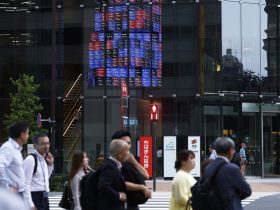In a bad market for banks, Citizens Financial‘s (NYSE:CFG) share price performance has been absolutely brutal, falling more than 40% since my last update and surpassing the 27% or so decline in the regional bank group by a wide margin. Worries about higher capital requirements have played a role, but Citizens has also been hit hard by higher funding costs, limited operating leverage, and the wrong mix of assets and markets for the current environment.
The stock call here is challenging given valuation, serious near-term headwinds (to both the financials and sentiment), and other factors like an unusually large dividend that should be sustainable. Low single-digit long-term core growth of less than 2% can support a fair value above $40, while shorter-term multiples-based approaches support a low-$30’s share price. The problem is that not much is really going to be going Citizens’ way until 2025, and barring a rally in the sector that sees bargain-hunting for some of the most beaten-up names in the space (not likely, I think until there’s more visibility on rate cuts) this name could languish a while longer.
Poor Core Results As Earnings Drivers Come Under Stress
Nothing really went Citizens’ way above the pre-provision profit line, and I’m concerned that this is going to be the dominant story for several more quarters. Better provisioning helped, but with the credit cycle normalizing (higher losses) and the economy slowing, that’s not likely to continue to be a positive driver.
Revenue fell about 8% year over year and close to 4% quarter over quarter, missing expectations by close to 2% or about $0.055/share. Net interest income (on an FTE basis) declined close to 9% yoy and 4% qoq, just missing expectations (a half-penny miss). Net interest margin was slightly better than expected (down 14bp to 3.03% versus a sell-side average estimate of 3.02%) while earning asset growth (down about 1% qoq) was slightly worse.
Fee-based revenue fell about 5% yoy and 2% on a core adjusted basis, coming in at about $0.05/share below expectations. Card and trust fees were both down from the prior quarter, but it was a weak capital markets business (down 18%) that did a lot of the damage.
Operating expenses rose more than 6% yoy and 3% qoq, missing by about $0.015/share and the efficiency ratio of 63.1% is not particularly good for a super-regional bank. Pre-provision profits plunged 25% yoy and 13% qoq, one of the weakest performances of the larger banks so far and about $0.07/share worse than expected.
A lower loan loss provision, tax rate and share count largely plugged the gap between pre-provision earnings and bottom line numbers. Tangible book value per share was down more than 3% qoq, and the CET1 ratio ticked up slightly to 10.4% (from 10.3%), which is fine relative to requirements.
Both Sides Of The Balance Sheet Remain Under Pressure
Due to management’s decision earlier in the year to reduce non-core lending businesses, loans are lagging the broader market numbers. In the third quarter, loans declined 4% yoy and 1% qoq on an end-of-period basis, well below the 1.5% yoy growth seen across larger banks and the 4% growth seen across the banking sector as a whole.
Commercial (or C&I) lending declined 5% yoy and 1% qoq, all the more disappointing as this is among the more attractive segments of lending right now on a rate and credit quality basis. CRE lending was better (up 3% yoy and 2% qoq), while consumer lending (down 3% yoy and 1% qoq) was pressured by weaker student lending (down 1% qoq) and auto lending (down 11% qoq). In a quarter where 20bp sequential improvement in loan yields has been oddly common, Citizens logged a 14bp improvement (to 5.66%), with the bank’s large and lower-yielding mortgage business keeping a lid on yield growth.
Looking at funding, total deposits were flat and that’s actually one of the better results so far this quarter (Synovus (SNV) and U.S. Bancorp (USB) did better, but USB had a boost from M&A). The details aren’t as positive, as Citizens had to offset non-interest deposit pressure (down 26% yoy and 4% qoq) with more money market and time deposits, driving the cost of interest-bearing deposits up almost 40bp to over 2.6% and the total costs of deposits up more than 30bp to over 2%.
The cumulative interest-bearing deposit beta is now 48%, which isn’t that bad relative to many banks of similar size (M&T Bank (MTB), Synovus, and Zions (ZION) are all at or above that level), but loan beta is only around 46% and earning asset beta is around 40%. Citizens aren’t well-leveraged to a “higher for longer” rate environment, and the bank has significant swaps with negative carry as long as rates are above 5%, and these will start pressuring net interest income in 2H’24 (management has disclosed this multiple times, so it shouldn’t be a surprise).
The Outlook
Management has been working for years to try to upgrade this bank. These actions have included shrinking less desirable business lines, improving loan pricing, improving deposit-gathering, and driving better-operating efficiency. The results prior to the regional bank meltdown were mixed-to-positive – the bank had been making progress, but not as quickly as the Street wanted.
The bank also made a somewhat aggressive move earlier this year, bringing on 50 private bankers from First Republic to accelerate the company’s ambitions in what can be a lucrative business line. Between growing the private bank and leveraging past deals in the NYC area (Investors and HSBC), I think there are still some important positive drivers in place to go with the loan/deposit restructuring and operating efficiency improvements.
Now there’s more work to be done, and the bank’s suboptimal loan and deposit/funding mix are really hurting results and sentiment. Further deposit repricing and remixing will still weigh on Q4 results, and management’s target of flat operating expenses in 2024 (including reducing headcount and reconsidering some non-core businesses) seems ambitious. At the same time, there’s meaningful deterioration in areas like CRE-office that are going to weigh on provisions.
Between this year and next, I’m expecting a nearly 40% peak-to-trough decline in core earnings, and that’s one of the worst outlooks of the banks I cover frequently. I do expect a rebound as rate cuts later in 2024 boost 2025 and 2026 results, but the modeling changes drop my five-year expected core earnings growth rate to slightly negative and my long-term rate to a little less than 2%. Keep in mind, though, that as very highly levered businesses, small changes in modeling estimates drive large swings in earnings and Citizens could have more upside in the recovery cycle and more leverage from self-help – in other words, there’s still possible upside to that 2% earnings growth estimate.
Discounted core earnings suggest a fair value of around $40. Short-term approaches like ROTCE-driven P/TBV and P/E give me a fair value in the range of $31.50 to $34.50 using estimates like a 10% ROTCE in FY’24 and a 9.9x multiple on my FY’24 EPS estimate.
The Bottom Line
Citizens has been an absolutely lousy call, and I gave the bank far too much credit for having improved its operations going into this next phase of the cycle. The fact that deposit costs have risen more quickly than expected doesn’t really mitigate that, and management is back to square one when it comes to rebuilding investor confidence. I do think there’s still a value argument to make here, but with a lot of operational headwinds likely to stay in place for several more quarters, I’m worried that weak near-term results compared to peers will outweigh possible bargain-hunting.
Read the full article here












Leave a Reply